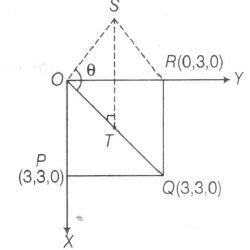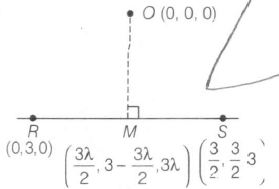Answer:
Option B,C,D
Explanation:
Given , square base OP=OR=3
$\therefore$ P(3,0,0) , R=(0,3,0)

Also, mid-point of OQ is $T\left(\frac{3}{2},\frac{3}{2},0\right)$
Since S is directly above the mid-point T of diagonal OQ and ST =3
i.e, $S\left(\frac{3}{2},\frac{3}{2},3\right)$
Here , DR's of OQ (3,3,0) and DR's of OS $(\frac{3}{2},\frac{3}{2},3)$
$\therefore\cos \theta=\frac{\frac{9}{2}+\frac{9}{2}}{\sqrt{9+9+0}\sqrt{\frac{9}{4}+\frac{9}{4}+9}}$
$=\frac{9}{\sqrt{18}.\sqrt{\frac{27}{2}}}=\frac{1}{\sqrt{3}}$
$\therefore$ Option (a) is incorrect.
Now, equation of the plane containing the $\triangle OQS $ is
$\begin{bmatrix}x & y& z \\3 & 3 &0\\3/2 &3/2&3\end{bmatrix}\Rightarrow0\Rightarrow\begin{bmatrix}x &y &z \\1 & 1 &0 \\ 1&1&2\end{bmatrix}=0$
$\Rightarrow x(2-0)-y(2-0)+z(1-1)=0$
$\Rightarrow 2x-2y=0 $ or x-y=0
$\therefore$ Option (b) is correct.
Now, length of the perpendicular from P(3,0,0) to the plane containing $\triangle OQS $ is
$\frac{|3-0|}{\sqrt{1+1}}=\frac{3}{\sqrt{2}}$
$\therefore$ Option (c) is correct.
Here, equation of RS is
$\frac{x-0}{3/2}=\frac{y-3}{-3/2}=\frac{z-0}{3}=\lambda$
$\Rightarrow x=\frac{3}{2}\lambda, y=-\frac{3}{2}\lambda+3, z=3\lambda$
To find the distance from O(0,0) to RS.
Let M be the foot of perpendicular.

$\therefore$ $\overline{OM}\perp\overline{RS}\Rightarrow\overline{OM}.\overline{RS}=0$
$\Rightarrow \frac{9\lambda}{4}-\frac{3}{2}\left(3-\frac{3\lambda}{2}\right)+3(3\lambda)=0$
$\Rightarrow $ $\lambda=\frac{1}{3}$
$\therefore$ $M\left(\frac{1}{2},\frac{5}{2},1\right)$
$\Rightarrow OM=\sqrt{\frac{1}{4}+\frac{25}{4}+1}=\sqrt{\frac{30}{4}}=\sqrt{\frac{15}{2}}$
$\therefore$ Option (d) is correct